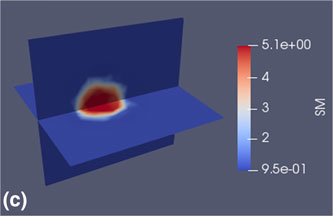Crossref Citations
This article has been cited by the following publications. This list is generated based on data provided by
Crossref.
Candito, Antonio
Palacio‐Torralba, Javier
Jiménez‐Aguilar, Elizabeth
Good, Daniel W.
McNeill, Alan
Reuben, Robert L.
and
Chen, Yuhang
2020.
Identification of tumor nodule in soft tissue: An inverse finite‐element framework based on mechanical characterization.
International Journal for Numerical Methods in Biomedical Engineering,
Vol. 36,
Issue. 8,
Olson, Lorraine G.
Throne, Robert D.
Rusnak, Emily I.
and
Gannon, Jonathan P.
2021.
Force-based stiffness mapping for early detection of breast cancer.
Inverse Problems in Science and Engineering,
Vol. 29,
Issue. 12,
p.
2239.
Ghosh, Soham
Cuevas, Victor Crespo
Seelbinder, Benjamin
and
Neu, Corey P.
2021.
Image‐Based Elastography of Heterochromatin and Euchromatin Domains in the Deforming Cell Nucleus.
Small,
Vol. 17,
Issue. 5,
Goenezen, Sevan
Kim, Baik Jin
Kotecha, Maulik
Luo, Ping
and
Hematiyan, Mohammad R.
2021.
Mechanics Based Tomography (MBT): Validation using experimental data.
Journal of the Mechanics and Physics of Solids,
Vol. 146,
Issue. ,
p.
104187.
Goenezen, Sevan
Kotecha, Maulik C
and
Reddy, Junuthula N
2022.
Identification of the 3D crystallographic orientation using 2D deformations.
The Journal of Strain Analysis for Engineering Design,
Vol. 57,
Issue. 6,
p.
445.
Shafiei Dizaji, M.
Alipour, M.
and
Harris, D.K.
2022.
Image-Based Tomography of Structures to Detect Internal Abnormalities Using Inverse Approach.
Experimental Techniques,
Vol. 46,
Issue. 2,
p.
257.
Olson, Lorraine G.
and
Throne, Robert D.
2022.
Stiffness mapping for early detection of breast cancer: combined force and displacement measurements.
Engineering with Computers,
Vol. 38,
Issue. 5,
p.
4023.
Xu, Tian
Wang, Zhen
Hu, Yingda
Du, Shilun
and
Lei, Yong
2023.
A multiple-data-based direct method for inverse problem in three-dimensional linear elasticity.
International Journal of Mechanical Sciences,
Vol. 259,
Issue. ,
p.
108600.
Xu, Tian
Wang, Zhen
Hu, Yingda
Du, Shilun
Du, Ao
Yu, Zhenyang
and
Lei, Yong
2023.
A FEM-based direct method for identification of Young’s modulus and boundary conditions in three-dimensional linear elasticity from local observation.
International Journal of Mechanical Sciences,
Vol. 237,
Issue. ,
p.
107797.
Nguyen, Hieu Van
Lee, Se-Hyeok
and
Lee, Jin Ho
2023.
Application of the Unscented Kalman Filter to Estimate the Material Properties of a Layered Half-Space.
International Journal of Applied Mechanics,
Vol. 15,
Issue. 02,
Mei, Yue
Deng, Jianwei
Zhao, Dongmei
Xiao, Changjiang
Wang, Tianhang
Dong, Li
and
Zhu, Xuefeng
2024.
Toward Improved Accuracy in Quasi-Static Elastography Using Deep Learning.
Computer Modeling in Engineering & Sciences,
Vol. 139,
Issue. 1,
p.
911.
Xu, Tian
Li, Murong
Wang, Zhen
Hu, Yingda
Du, Shilun
and
Lei, Yong
2025.
A direct method to identify Young’s moduli and boundary conditions of the heterogeneous material.
International Journal of Mechanical Sciences,
Vol. 285,
Issue. ,
p.
109777.
Masoumi, Farshid
and
Lu, Jia
2025.
Identifying hyperelastic material parameters using force balance and partial displacement data.
International Journal of Solids and Structures,
Vol. 313,
Issue. ,
p.
113283.
